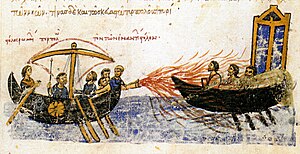Rus'–Byzantine War (941)
This article needs additional citations for verification. (January 2017) |
| Siege of Constantinople by the Rus | |||||||
|---|---|---|---|---|---|---|---|
| Part of Rus'-Byzantine Wars | |||||||
 Greeks using their lethal fire, from the Madrid Skylitzes manuscript. | |||||||
| |||||||
| Belligerents | |||||||
| Byzantine Empire | Rus' | ||||||
| Commanders and leaders | |||||||
|
Theophanes Bardas Phokas John Kourkouas |
Igor I of Kiev | ||||||
| Strength | |||||||
| 15 ships (initially)[citation needed] | 1,000 ships, c. 40,000 men[n 1] | ||||||
The Rus'–Byzantine War of 941 took place during the reign of Igor of Kiev.[n 2] The first naval attack was driven off and followed by another, successful offensive in 944.[6] The outcome was the Rus'–Byzantine Treaty of 945.[7]
The invasion

The
Lecapenus arranged a defense of
The Byzantines thus managed to dispel the Rus' fleet but not to prevent the pagans from pillaging the hinterland of Constantinople, venturing as far south as Nicomedia. Many atrocities were reported: the Russian Primary Chronicle said that the Rus’ used their victims for target practice or drove nails into their heads.[9] Several Byzantine historians (probably the Russian Primary Chronicle’s source for the information), provide additional details that the Rus’ crucified some of their captives and staked out others on the ground.[10] [11]
In September,
Aftermath
Footnotes
- Liudprand of Cremonawrote that the fleet numbered only 1,000 ships; Liudprand's report is based on the account of his step-father who witnessed the attack while serving as envoy at Constantinople. Modern historians find the latter estimate to be the most credible. Runciman (1988), p. 111.
- Oleg of Novgorodas the leader of the expedition, though according to traditional sources he had been dead for some time. See, e.g., Golb 106-121; Mosin 309-325; Zuckerman 257-268; Christian 341-345.
References
Notes
- ^ Mauricio Borrero. Russia: A Reference Guide from the Renaissance to the Present. 2004. P. 389: "941–944: Igor leads expedition on Constantinople".
- ^ James Stuart Olson, Lee Brigance Pappas, Nicholas Charles Pappas. An Ethnohistorical Dictionary of the Russian and Soviet Empires. Greenwood Publishing Group, 1994. P. 767: "944: Igor ends his expedition against Constantinople".
- ^ https://www.sedmitza.ru/lib/text/441064/
- ^ Janet Martin. Treasure of the Land of Darkness: The Fur Trade and Its Significance for Medieval Russia. Cambridge University Press, 2004. P. 115-116
- ^ Alexander A. Vasiliev. History of the Byzantine Empire, 324–1453. University of Wisconsin Press. P. 322
- ^ Mauricio Borrero. Russia: A Reference Guide from the Renaissance to the Present. 2004. P. 389
- ^ Janet Martin. Treasure of the Land of Darkness: The Fur Trade and Its Significance for Medieval Russia. Cambridge University Press, 2004. P. 115-116: "In 941 and 944 the Rus' again launched attacks on the Byzantine Empire. Although the first was a total failure, the second resulted in a new treaty (945)".
- ^ Liutprand of Cremona, Antapodosis (Tit for Tat), Book 5, Chapter 15, in The Works of Liutprand of Cremona, F. A. Wright, ed. and trans., (London: George A. Routledge and Sons, 1930), pp. 185-186.
- ^ Повесть временных лет. Том 1. По лаврентьевской летописи (The Tale of Bygone Years [also known as the Russian Primary Chronicle], Volume 1, The Laurentian Chronicle), Dmitry S. Likhachev, et al., eds. (Moscow and Leningrad: Academy of Sciences of the Soviet Union, 1950), p. 33.
- ^ John Skylitzes, A Synopsis of Byzantine History, Chapter 10, Section 31, John Wortley, ed. and trans.(Cambridge: University Press, 2010), p. 221.
- ^ The Chronicle of George Hamartolos, in Jacques Paul Migne, ed., Patrologiae Cursus Completus, Series Graeca, vol. 110, cols. 1179-1182.
- ^ Janet Martin. Treasure of the Land of Darkness: The Fur Trade and Its Significance for Medieval Russia. Cambridge University Press, 2004. P. 115-116
- ^ Janet Martin. Medieval Russia, 980-1584. Cambridge University Press, 2007. P. 19
- ^ Vilhelm Ludvig Peter Thomsen. The Relations Between Ancient Russia and Scandinavia, and the Origin of the Russian State. Cambridge University Press. 2010. P. 25
- ^ Alexander A. Vasiliev. History of the Byzantine Empire, 324–1453. University of Wisconsin Press. P. 322
- ^ Alexander A. Vasiliev. History of the Byzantine Empire, 324–1453. University of Wisconsin Press. P. 322
- ^ Janet Martin. Treasure of the Land of Darkness: The Fur Trade and Its Significance for Medieval Russia. Cambridge University Press, 2004. P. 115-116
- ^ Alexander A. Vasiliev. History of the Byzantine Empire, 324–1453. University of Wisconsin Press. P. 322
Sources
- Christian, David (1998). A History of Russia, Central Asia and Mongolia. Vol. 1. Oxford: Blackwell. ISBN 0-631-18321-3.
- ISBN 0-8014-1221-8.
- Harris, Jonathan (2007). Constantinople: Capital of Byzantium. London: Hambledon Continuum. ISBN 978-1-84725-179-4.
- ISBN 0-486-43396-X.
- Logan, Donald F. (1992). The Vikings in History (2nd ed.). London: Routledge. ISBN 0-415-08396-6.
- Mošin, Vladimir Aleksijevič (1931). "Les Khazares et les Byzantins d'apres l'Anonyme de Cambridge". Byzantion. 6: 309–325.
- ISBN 978-0-521-35722-7.
- Uspensky, Fyodor (1997). The History of the Byzantine Empire. Vol. 2. Moscow: Mysl.
- .
